

This site is supported by our readers. We may earn a commission, at no cost to you, if you purchase through links.
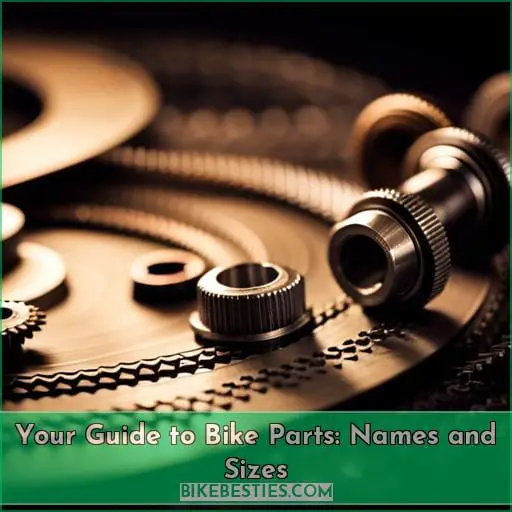
Ready to dive into the world of bike parts? Your guide to bike parts names and sizes is here to help you navigate the intricate details of your two-wheeled machine.
From frame tubes and wheelset components to groupset parts and brakes, we’ll break down each component and explain its purpose. Whether you’re a beginner or an experienced cyclist, this guide will empower you with knowledge so that you can master your bike’s anatomy like a pro.
Let’s get started!
Table Of Contents
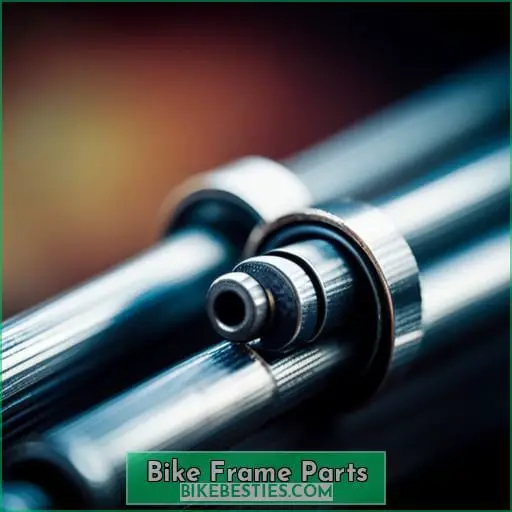
Let’s start by discussing the key components of a bike frame.
The frame is the backbone of your bicycle, providing structural support and determining its overall strength and stability.
These tubes work together to create a strong double-diamond design that supports both rider weight and external forces during riding.
Additionally, the fork plays a crucial role as it supports the front wheel while also allowing for steering control through its connection with handlebars.
When it comes to bike frame parts, the frame tubes play a crucial role in providing structural support and stability while you ride.
Different Material Varieties offer varying levels of strength, weight, and comfort.
Tube Reinforcement Techniques are used to enhance durability and stiffness.
The Evolution in Tubing Technology has led to advancements in frame materials for improved ride quality and responsiveness.
Now let’s move on to the fork, an essential component of a bike frame that supports the front wheel and allows for steering control.
The fork comes in different suspension types, such as rigid, coil-sprung, or air-sprung forks.
Material variations include aluminum alloy or carbon fiber for lightweight performance.
Fork geometry plays a crucial role in determining handling characteristics and stability.
Travel options range from short-travel forks for cross-country riding to long-travel forks suited for downhill adventures.
Regular maintenance is important to ensure smooth operation and prolong the lifespan of your fork.
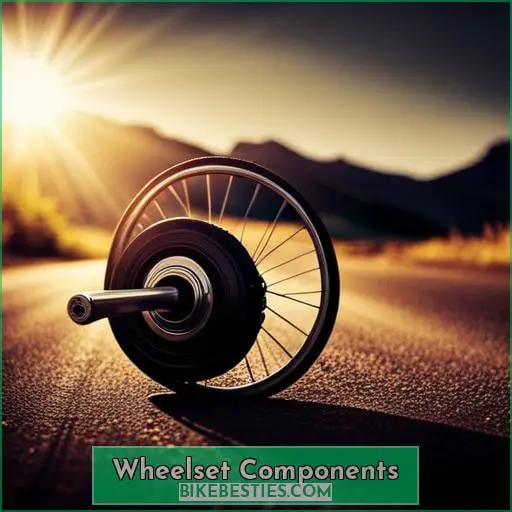
Now let’s talk about the essential components of a wheelset:
The hub is the central part of the wheel that attaches to the bike frame and houses bearings for smooth rotation.
The rim is what holds your tire in place and provides stability during rides.
Spokes connect the hub to the rim, providing strength and support for your wheels.
And finally, we’ve tires – they come in various sizes and tread patterns depending on your riding style and terrain preferences.
To understand the wheelset components of a bike, let’s start with the hub. The hub is like the heart of your wheelset, responsible for connecting the spokes to hold everything together.
Here are some key points about hubs:
Choosing the right rim is essential for optimal performance and durability of your bike.
Rim materials, such as aluminum or carbon fiber, determine strength and weight.
Consider rim braking compatibility when selecting rims for your bike.
Rim width affects tire dimensions and can impact ride quality.
Pay attention to rim design to ensure proper tire installation and compatibility with tubeless tires.
Regular maintenance like truing the rims will keep them in top shape for a smooth ride.
Take a closer look at the spokes, which connect the hub to the rim and provide structural support for your bike’s wheelset.
Spokes can be made of steel or high-end carbon, offering strength and durability.
Different spoke patterns, such as radial or cross-laced, affect wheel stiffness and stability.
Proper spoke tension is crucial for maintaining a strong wheelset.
Regular maintenance includes checking for loose or broken spokes and ensuring proper lacing to optimize performance.
Now let’s dive into the tire, an essential component of your bike’s wheelset.
The tire isn’t just a piece of rubber; it plays a crucial role in determining your ride quality.
From maintaining proper tire pressure to choosing the right tread patterns and widths for different terrains, understanding these aspects will enhance your cycling experience.
Additionally, knowing how to repair punctures and when it’s time for a tire replacement can save you from unexpected setbacks on the road or trail.
Don’t underestimate the importance of tires in achieving optimal performance and control while enjoying that liberating feeling on two wheels!
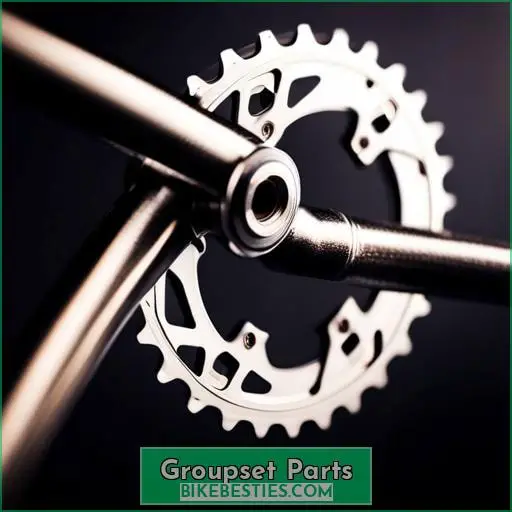
Now let’s talk about the essential parts of a bike’s groupset:
The crankset consists of crank arms and chainrings that transfer your pedaling power to the drivetrain.
The chain connects the chainrings to the cassette or cogset at the back, while both front and rear derailleurs facilitate smooth gear changes by moving the chain between different gears.
Understanding these groupset components will help you maintain optimal performance on your bike.
The crankset is a key component of the groupset on your bike. It consists of the crank arms, chainrings, and bottom bracket.
To ensure optimal performance, regular maintenance is crucial. Keep an eye on wear and tear, regularly clean and lubricate the components to extend their lifespan.
When replacing or upgrading your crankset, make sure it’s compatible with other parts of your groupset such as the rear derailleur and cassette for smooth shifting and efficient power transfer during rides.
To ensure smooth and efficient gear shifting, the chain is a vital component of your bike’s groupset. Proper maintenance and care of your chain are essential for optimal performance.
Adjustability is a key feature of the front derailleur, allowing you to easily switch between different chainrings while riding. To ensure smooth gear changes, it’s important to understand adjustment techniques and compatibility factors when installing or replacing a front derailleur.
Follow proper mounting instructions and make necessary tension adjustments for optimal performance. Different front gear types may require specific derailleurs, so choose one that suits your bike’s tire diameter and overall size.
| Front Derailleur |
|---|
| Adjustment Techniques |
| Compatibility Factors |
| Mounting Instructions |
When it comes to the components of a bike’s groupset, an essential part is the rear derailleur. Working in conjunction with the front derailleur, it ensures smooth and precise gear changes. To optimize performance, proper adjustment techniques are crucial for compatibility and shifting mechanisms.
Regular maintenance tips include cleaning and lubricating the derailleurs for optimal function. Upgrading to a higher-quality rear derailleur can also enhance overall performance on hardtail bikes equipped with disc brakes or tubeless tires.
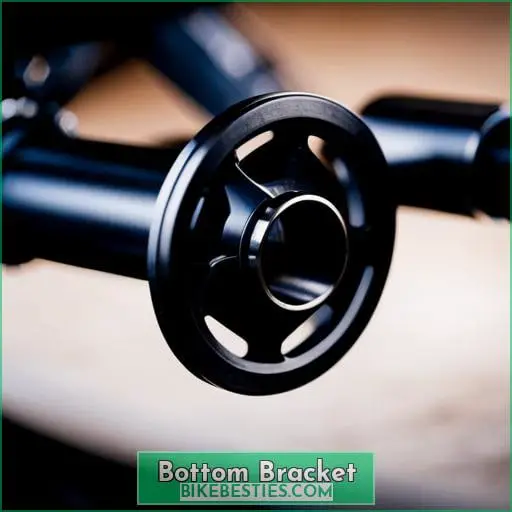
The bottom bracket is a crucial component of your bike’s drivetrain system.
It connects the crankset to the frame, allowing smooth rotation and power transfer.
When it comes to maintenance, regular cleaning and lubrication are essential for optimal performance.
Check for any excessive play or noise that may indicate worn bearings or damage.
For installation, make sure you choose a bottom bracket compatible with your frame type (threaded or press-fit) and crankset style (such as square taper, external bearing, or BB30).
Material comparison reveals options like steel, aluminum alloy, titanium alloy,and ceramic bearings each offering different advantages in terms of durability and weight savings.
Upgrading options exist too; consider investing in high-quality bottom brackets that can improve efficiency by reducing friction between moving parts.
Alongside upgrading stem,rims handlebar,& seatpost ,the right bottom bracket choice can enhance your overall riding experience.
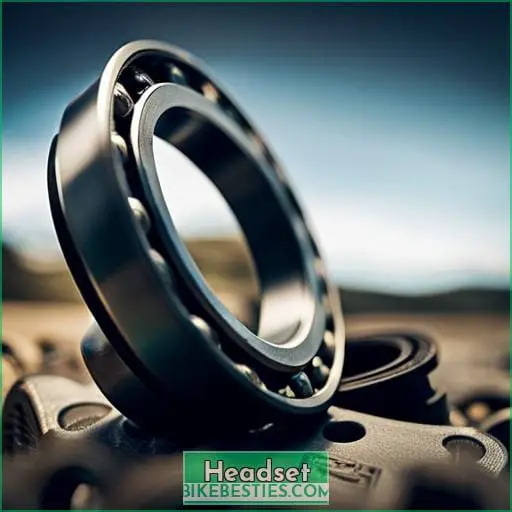
Moving on from the bottom bracket, let’s now dive into an essential component of your bike: the headset. This small but mighty part plays a crucial role in ensuring smooth steering and control while you conquer those trails or cruise along the roads.
By following these adjustment techniques, maintenance tips, and compatibility checks outlined above during installation or routine inspections,you’ll have full mastery over your headset’s performance–allowing you to experience ultimate liberation as you navigate any terrain with power and precision!
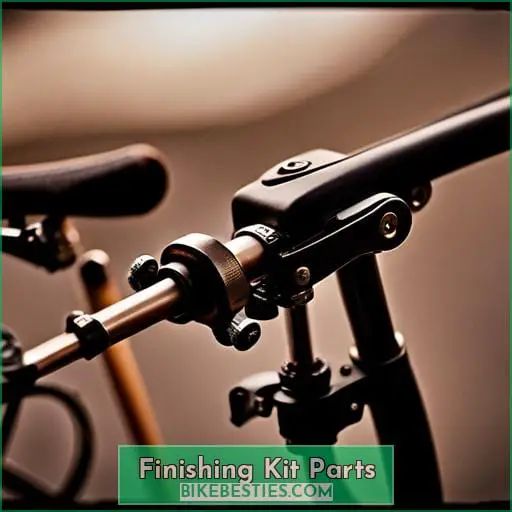
Now let’s talk about the finishing kit parts that complete your bike setup.
The seatpost, stem, handlebar, and saddle are all essential components that contribute to your comfort and control on the bike.
The seatpost allows you to adjust the height of your saddle for optimal pedaling position, while the stem connects your fork’s steerer tube to the handlebars.
Speaking of which, different handlebar shapes and materials can affect how you grip and maneuver your bike.
And finally, finding a comfortable saddle is crucial for long rides or races where every ounce of discomfort matters.
To continue our discussion on the various finishing kit parts of a bike, let’s now explore the seatpost.
The seatpost is an adjustable component that supports your saddle and allows you to find the ideal height for comfort and efficiency. It’s important to consider factors such as adjustment techniques, material innovations, saddle ergonomics, height compatibility with your frame size, and maintenance tips to ensure optimal performance.
| Seatpost | Description |
|---|---|
| Adjustment Techniques | Various mechanisms like quick-release or bolted designs allow easy height adjustments for different riding situations. |
| Material Innovations | Seatposts are made from materials like aluminum alloy or carbon fiber for strength and weight savings. |
| Saddle Ergonomics | Different seatposts offer flexibility in terms of setback (horizontal position) or offset (vertical position), allowing riders to fine-tune their saddle position. |
| Height Compatibility | Ensure that the diameter of your seat tube matches with the diameter of your chosen seatpost before installation |
| Maintenance Tips | Regularly inspecting and cleaning your seatpost can prevent issues such as slipping or corrosion. |
By understanding these aspects related to a bike’s finishing kit components like the seatpost, you can achieve greater control over both yourself and machine – giving you that sense of liberation as you conquer new challenges on two wheels!
Continuing with the discussion on bike parts, let’s now explore the stem, which plays a crucial role in connecting the fork’s steerer tube to your handlebars.
The stem is available in different materials like aluminum alloy and carbon fiber, offering strength and lightweight performance options.
You can also choose from various stem lengths and angle options to customize your riding position.
When installing a stem, make sure it’s securely tightened using proper torque specifications for safety reasons.
Stem customization trends allow riders to express their unique style and preferences.
Now let’s take a closer look at the handlebar, an essential component of the bike’s finishing kit.
The handlebar comes in various shapes and materials to suit different riding styles and preferences.
You can choose from drop bars for road bikes or flat bars for mountain bikes.
Handlebars also vary in width, allowing you to find the perfect fit for your body size and riding needs.
Additionally, handlebars offer adjustability options so you can fine-tune your position on the bike.
To enhance comfort and grip, consider investing in quality handlebar grips that provide cushioning and control while cycling.
When choosing a saddle for your bike, it’s important to consider:
Saddle manufacturers offer a range of options with various comfort features and ergonomic designs.
Anatomical considerations such as cutouts or gel padding can enhance performance by reducing pressure points.
So whether you’re looking for endurance support or aggressive racing ergonomics, there’s a saddle out there to help you conquer the road or trail with power and mastery.
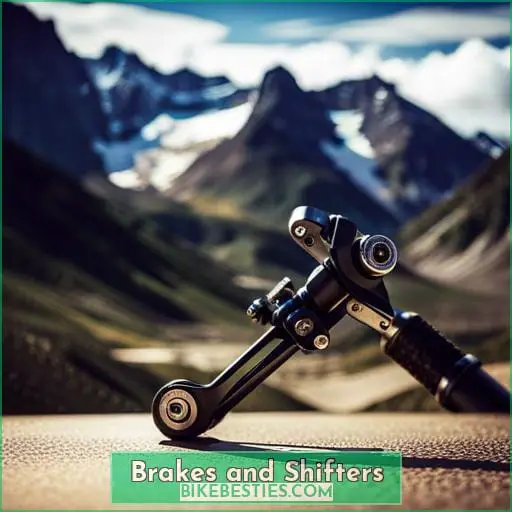
Now let’s talk about the essential components that control your bike’s speed and gear shifting:
Disc brakes are commonly used for their reliable stopping power, whether hydraulically or mechanically operated.
Rim brakes are a lighter option mounted on the frame but provide slightly less power than disc brakes.
And when it comes to changing gears smoothly and efficiently, gear shifters play a crucial role in seamlessly moving between different chainrings and sprockets.
To operate your bike’s disc brakes, simply squeeze the brake levers.
Disc brakes offer superior stopping power compared to rim brakes, making them ideal for riders seeking maximum control and safety.
Regular brake maintenance is crucial to ensure optimal performance and longevity.
It’s important to regularly check and replace worn-out brake pads for consistent braking power.
Hydraulic systems provide smooth modulation and require less effort at the lever compared to mechanical systems.
Brake rotor design plays a role in heat dissipation and overall braking performance.
Start by familiarizing yourself with rim brakes, as they’re a common type of brake system found on bicycles.